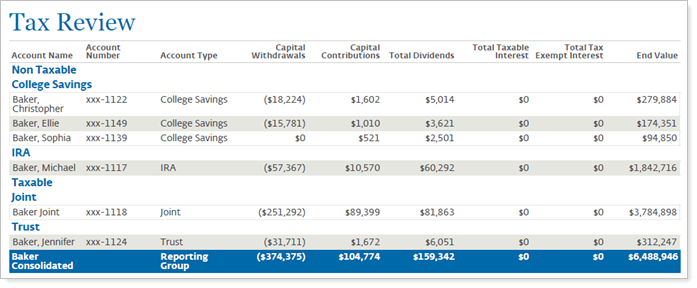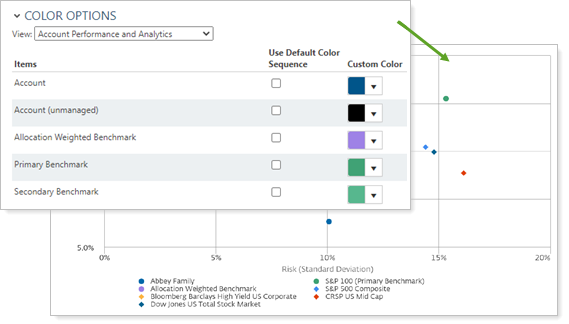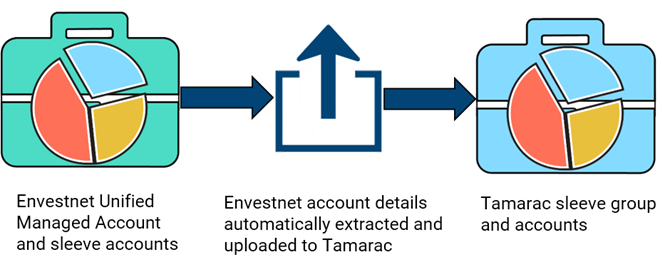Contents
Reporting
Evaluate Tax Summary Data on the Comparative Review Report
Best Practice
This report is intended to provide guidance for advisors and investors. It does not replace official tax forms. Always use the custodian's documents as the source of record when filing taxes.
During tax season, you and your clients work hard to gather all the information accountants need to build efficient tax filing strategies. To provide a comprehensive tax planning estimate, you used to collect data from at least three different reports across Tamarac. Now we bring all this data together in the new tax planning version of the Comparative Review PDF report, streamlining your process, saving you time, and making it much easier to deliver relevant tax details.
Note that only the PDF template version of the Comparative Review report includes the tax planning data options.

In the tax planning version of the Comparative Review report, you group accounts by tax status and include detailed tax planning data points for various income and expense sources, realized gains and losses, and more.

To create a tax planning Comparative Review PDF template, set Reporting data type to Tax planning data in the PDF template settings.

When you select Tax planning data, in addition to the tax planning columns, you can customize the report with the following settings:
-
Include tax planning data for non-taxable accounts. Control the report complexity by showing or hiding certain tax-specific columns for non-taxable accounts.

-
Include capital gains distributions in realized gain/loss columns. Include or exclude capital gains in realized gain and loss calculations. To make sure that totals and subtotals add up, you can't add capital gains-specific columns separately if you include capital gains in realized gains and losses.

To learn more about the tax planning version of the Comparative Review PDF report, see Tax Planning Report.
Improved Consistency on the Account Analytics Report
The Account Analytics report helps you evaluate the return you're getting for each unit of risk in comparison with a benchmark, giving you and your clients confidence in the investment strategy suitability. This release, we're aligning some of the Account Analytics behavior with other reports for greater consistency across the platform.
Changes you'll see include:
-
More consistent themes. We are working to ensure that when you use the same theme for Account Analytics and Account Performance PDF templates, colors of data points representing accounts, benchmarks, and indexes match.

-
Linked Split Return periods. Periods where holdings gaps occurred will now link returns across the holdings periods. For more information, see Show Returns Across Holdings Gaps. The exact report behavior depends on your firm's settings. Contact your Tamarac support team for details about your firm's calculation settings.
-
Updated observation periods. We simplified how date periods work when an asset wasn't held at the beginning of the period. Now the first period spans from the first day the assets were held to the last day of the period. After that, the period begins and ends as scheduled. For example, an account opens on the 17th. Although monthly periods generally start on the 1st and end on the last day of the month, in this case, the period begins on the 17th and ends on the last day of the month.
-
Slight change to Upside and Downside Capture Ratio calculation. The upside capture ratio now includes 0.00% index return observations. For both upside and downside capture ratios, the variable y is defined as the number of years, counting either only positive periods (upside) or negative periods (downside). For more information, see Upside Capture Ratio.
For more information, see Account Analytics Report.
Run Syncs Longer Than 31 Days
Occasionally you'll notice an issue with your data that you need to adjust. Perhaps you added manual security snapshots, tweaked transaction or pricing data in your Portfolio Accounting System, or updated security details that impact calculated values like accrued interest or bond amortization.
To see those changes on reports, you need to sync a long way back. Before, you couldn't do this yourself—you had to contact your support team to request a sync going back further than 31 days. This release, we give you more flexibility and help you increase efficiency by allowing you to run syncs going back as far as the inception of the firm without contacting your Support team.

Running longer syncs can take a significant amount of time, during which clients and firm users will not be able to access the site. We recommend running a sync only as far back as you need to capture the change that will impact returns or holdings within the period.
Because running longer syncs can cause the site to be unavailable, you may consider reviewing which firm users have permissions to run a sync. To manage sync permissions, look for Setup | Sync Data From Portfolio Center when you Manage Permissions for Roles.
For more information about syncs, see Synchronize Data From Portfolio Accounting System.
See Warnings for Invalid Upload Headers
When you perform a bulk upload, Tamarac Reporting ignores columns with headers that don’t match the upload data specifications. This ensures that one header typo doesn't stop your entire upload, but it can mean you have partially successful uploads where some data is added but some is omitted. It's not always easy to tell when this happens or what data may not have been uploaded successfully.
With this release, you will see a warning on the Upload Status page when your data set includes an invalid column header. This allows you to verify that everything you intended to upload is included without having to manually audit every column header in your upload file.

For more information about bulk upload errors and the Upload Status page, see Bulk Data Uploading.
Integrations
Automatically Access 1099s and Other Schwab Documents in the Document Vault
With tax time approaching, you and your clients start thinking about collecting 1099s and the other documents tax preparers need. Especially for clients with complex investments, even gathering documents isn't always straightforward. We've made life a little easier for you this release by giving you access to Schwab documents through the Tamarac document vault.
With this integration enhancement, you will be able to see and download tax files, statements, and trade confirmations from Schwab directly in the Tamarac document vault. You can then share those files directly with clients as needed.

Each folder displays files for the member accounts of the Household selected in the Find Documents For list. To narrow down the available documents, filter the documents with the date selector.

Schwab folders are automatically created and populated with files in your advisor document vault. To see Schwab files in the document vault:
-
You must have the Schwab integration enabled. For more information, see Enrollment in Schwab OpenView Gateway Integration.
-
The account must have Charles Schwab assigned as the account custodian.
For more information, see Schwab OpenView Gateway Integration.
See and Report on Envestnet Unified Managed Accounts in Tamarac with Sleeves
Tamarac now offers a seamless integration to see Envestnet UMAs and associated sleeve accounts in Tamarac as sleeve groups and accounts for firms using the Tamarac unified managed accounts (UMAs) initiative on the Envestnet ENV 2 platform. This enhancement brings another piece of clients' financial puzzle together in Tamarac, giving you and your clients a more complete view of their whole financial situation.

Envestnet UMAs that come in through this integration behave like standard sleeve groups and accounts in Tamarac. When you add them to add them to groups for reporting, you can account for those positions in your rebalancing decisions and include those accounts alongside the client's other Tamarac accounts in your analysis and reports.
For more information, see Envestnet Unified Managed Account Integration. Contact your dedicated Tamarac service team to start with this integration.
> Limitations
Once turned on, you will see sleeve groups and accounts created immediately, but it may take up to three days for the holdings and transactions to appear in the accounts.
This is a one-way integration. All changes to Envestnet unified managed accounts must be made on the Envestnet platform. Changes to sleeve accounts in Tamarac will not be sent to Envestnet. You cannot rebalance Envestnet unified managed accounts in Tamarac.
Clearer Messaging for Linked Account Errors
Sometimes it's hard to tell why a linked account isn't getting updated. To help, we've clarified some of the messages you'll see for linked accounts when you need to enter new credentials or take action to resolve an issue, as well as when there's a technical difficulty you can't resolve.
For more information, see Yodlee Integration.
Platform Improvements & Performance Enhancements
As part of our ongoing effort to improve speed and reliability on the Tamarac Platform, we are continuing to make enhancements under the hood. This table highlights improvements we made since our last release:
| Improvement Made | Type of Improvement |
|---|---|
|
Thanks to some work our teams have done to optimize how we store transactions data, you could experience inception sync times up to 15% shorter on average and one-day sync times up to 5% faster. You may also notice some large transaction bulk reports generating up to 16% faster. |
Code/Database |
|
Our teams have optimized the way that the billing history custodian export data are generated. Now exports that used to take minutes to generate take only seconds. |
Code/Database |
|
We optimized the way calculations requested by the sync are batched so we can spread them more evenly across servers. This change not only speeds up sync times, but it also makes sync durations much more consistent. |
Code/Database |
|
We tweaked some under-the-hood upload configurations to facilitate more consistent realized gain/loss data flow from Charles Schwab. With this change, we ensure our process captures all custodial realized gain/loss data even in the rare case when we receive files later than the window we previously had configured. |
Code/Database |
|
We're improving how Tamarac connects with our integration partners by adding globally unique user IDs to Tamarac. This lays the foundation for future integrations, enhances security, and strengthens some current integration connections. |
Code/Database |
|
We know account management and organization is complicated. Not surprisingly, account sets can get complicated, too, with nested account sets bringing in members from other account sets. We've made some changes to ensure that the Tamarac Platform can smoothly handle even very large, complex account sets. |
Code/Database |
Learn More - Watch the Release Video


